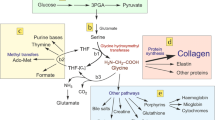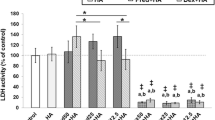Abstract
We investigated the influences of ketoprofen on the proteoglycan (PG) turnover of human articular cartilage explants in three groups: normal young with a high basal PG synthesis, normal adult and osteoarthritis cartilage, both with a low basal PG synthesis. Ketoprofen had no influence on the mean PG synthesis rate of normal adult and OA cartilage after 4 days of culture nor on the cartilage PG content after 8 days of culture. There was no relation between the histological grade of OA and effects of ketoprofen. In normal young cartilage ketoprofen induced an increase of the PG synthesis rate when added to the culture in a concentration of 10−4 M. No correlation existed between the effect of ketoprofen and the basal PG synthesis of normal cartilage.
Similar content being viewed by others
References
B. J. De Vries, W. B. Van Den Berg, E. Vitters and L. B. A. Van De Putte,The influence of antirheumatic drugs on basal and accelerated breakdown of articular proteoglycans. Agents and Actions23, 52–54 (1988).
M. J. Palmoski and K. D. Brandt,In vivo effect of aspirin on canine osteoarthritic cartilage. Arthritis Rheum.26, 994–1001 (1983).
L. S. McKenzie, B. A. Horsburgh, P. Ghosh and T. K. F. Taylor,Effect of antiinflammatory drugs on sulphated glycosaminoglycan synthesis in aged human articular cartilage. Ann. Rheum. Dis.35, 487–497 (1976).
M. J. Palmoski and K. D. Brandt,Effects of some nonsteroidal antiinflammatory drugs on proteoglycan metabolism and organization in canine articular cartilage. Arthritis Rheum.23, 1010–1020 (1980).
M. W. Whitehouse and H. Boström,The effect of some antiinflammatory (antirheumatic) drugs on the metabolism of connective tissues. Biochem. Pharmacol.11, 1175–1201 (1962).
K. D. Brandt and M. J. Palmoski,Effects of salicylates and other nonsteroidal antiinflammatory drugs on articular cartilage. Am. J. Med.77(1A), 65–69 (1984).
P. Ghosh,Antirheumatic drugs and cartilage. Clin. Rheumatol.2, 309–338 (1988).
B. J. De Vries, W. B. Van Den Berg and L. B. A. Van De Putte,In vivo and in vitro effects of tiaprofenic acid on glycosaminoglycan synthesis by intact murine articular cartilage. InTiaprofenic Acid. International Congress of Rheumatology. Excerpta Medica (Ed. O.G. Nilsen) pp. 69–74, Amsterdam 1985.
O. Huber-Bruning, B. Wilbrink, J. E. Vernooy, J. W. J. Bijlsma, W. Den Otter and J. Huber,Contrasting in vitro effects of retionol and mononuclear cell factor on young and old human cartilage. J. Pathol.150, 21–27 (1986).
J. Erlendsson, L. Ejstrup, N. Peters, Daugaard, A. Le Liboux, G. Jakobsen,Ketoprofen in plasma and synovial fluid. Ketoprofen summit conference, International Congress of Rheumatology, Sydney 1985.
W. S. Mitchell, P. Scott, A. C. Kennedy, P. M. Brooks, R. Templeton and M. G. Jeffries,Clinico-pharmacological studies on ketoprofen (‘Orudis’). Curr. Med. Res. Opin.3, 423–430 (1975).
A. A. Dogterom, O. Huber-Bruning, J. E. Vernooy, B. Wilbrink, W. Den Otter, J. Huber,Matrix depletion of young and old human articular cartilage by cultured autologous synovium fragments: a chondrocyte independent effect. Rheumatol. Int.5, 169–173 (1985).
P. Whiteman,The quantitative measurement of alcian blue glycosamino-glycan complexes. Biochem. J.131, 343–350 (1973).
G. P. J. Van Kampen, J. P. Veldhuijzen,Aggregated chondrocytes as a model system to study cartilage metabolism. Exp. Cell. Res.140, 440–443, (1982).
H. J. Mankin, H. Dorfman, L. Lipiello and A. Zarius,Biochemical and metabolic abnormalities in articular cartilage from osteoarthritic human hips. J. Bone Joint Surg.53A, 523–537 (1971).
M. J. Palmoski and K. D. Brandt,Proteoglycan depletion, rather than fibrillation, determines the effects of salicylate and indomethacin on osteoarthritic cartilage. Arthritis Rheum.28, 548–553 (1985).
D. A. Kalbhen,The influence of NSAIDs on morphology of articular cartilage. Scan. J. Rheumatol.77(suppl), 13–22 (1989).
S. Collier and P. Ghosh,Evaluation of the effects of antiarthritic drugs on the secretion of proteoglycans by lapine chondrocytes using a novel assay procedure. Ann. Rheum. Dis.48, 372–381 (1989).
K. D. Brandt and S. Slowman-Kovacs,Nonsteroidal antiinflammatory drugs in treatment of osteoarthritis. Clin. Orthop.213, 86–91 (1986).
Author information
Authors and Affiliations
Additional information
Part of the results were presented during the XVIIth ILAR Congress of Rheumatology, 1989. Abstract in: Scan. J. Rheum., 1989; Suppl. 83: 29–32.
Rights and permissions
About this article
Cite this article
Wilbrink, B., Van der Veen, M.J., Huber, J. et al. In vitro influence of ketoprofen on the proteoglycan metabolism of human normal and osteoarthritis cartilage. Agents and Actions 32, 154–159 (1991). https://doi.org/10.1007/BF01980867
Received:
Accepted:
Issue Date:
DOI: https://doi.org/10.1007/BF01980867




